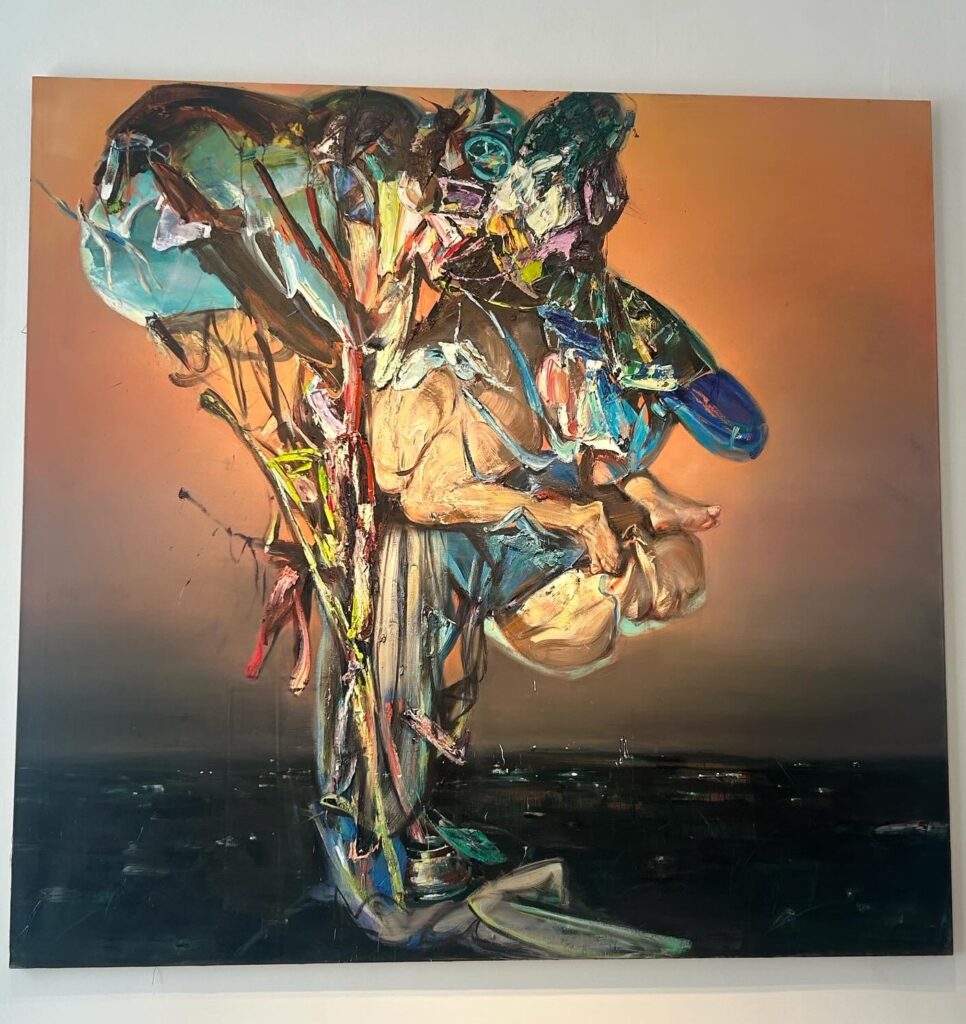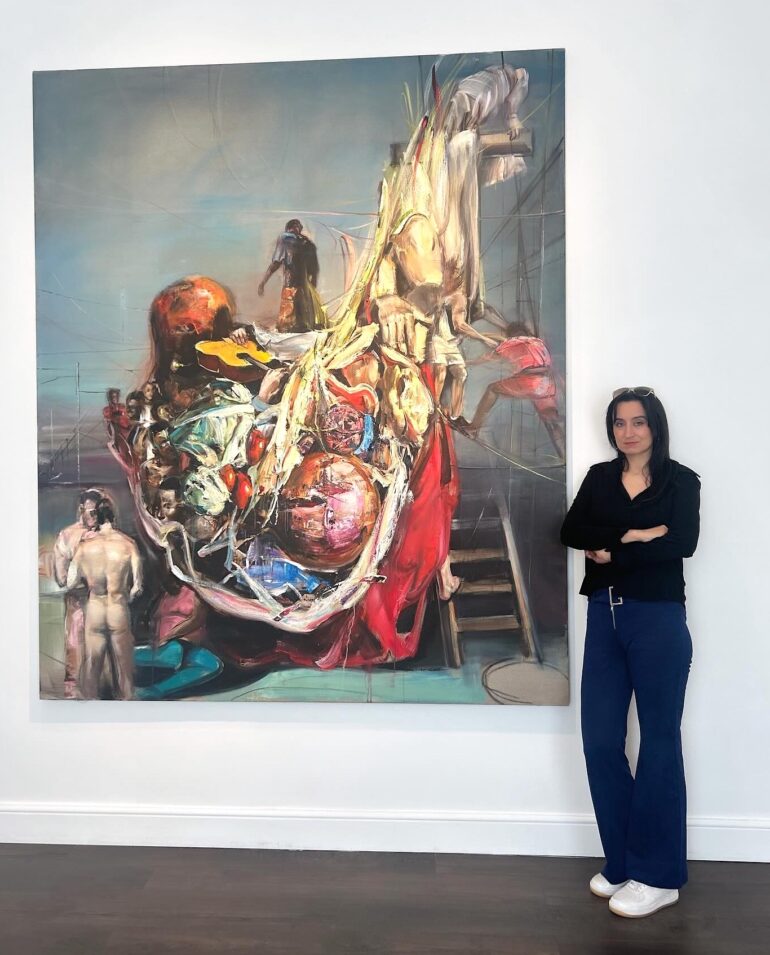‘Public Grapes – Anonymous Meat’ at Fiumano Clase in London features a series of powerful paintings by Bulgarian artist Andreana Dobreva.
The title of the exhibition is inspired by the Dadaist writings of author Eteri Nozadze (born Georgia, 1986), an emigrant herself, now living in Austria. Her Dadaistic book Giganbishe Trauben (sic) was written whilst she was still in the process of learning German and can be seen as a work that that shifts between art and poetry. The absurdity of the words and grammar is a direct comment on the absurdity of the ongoing difficulties faced by hundreds of thousands of people around the globe. War, climate change, political unrest and social injustices lead individuals to flee their homes, and often their families, in a desperate attempt to lead safer and better lives. The very fact that this occurs in the 21st century is shocking, it is also absurd and contradictory. Too often individuals become mere statistics and numbers. Stories are lost, histories wiped out and hope evaporates.

Dobreva spent eight years in Munich working with refugees of many nationalities. She taught German and assisted with paperwork and finding resources to help the settlement process. Even though each individual had their own unique story often they were treated as merely ‘migrants’ or ‘refugees’. Dobreva seeks to elevate the people she met and the experiences they spoke of. In effect she is creating contemporary history paintings, depicting tales of journeys endured and futures yet to be realised.
A highlight of the exhibition is ‘Field work II’, a large scale oil on canvas depicting a figure seen from behind embracing an abstract anonymous form, inviting the viewer to imagine their story. Dobreva’s dramatic brushstrokes, abstracted figures and use of impasto lends the canvases a visceral feeling that evokes the drama of Gericault or Delacroix, with the primal undercurrent of Francis Bacon.
Andreana Dobreva was born in 1982 in Sliven, Bulgaria. Her solo exhibitions include; “Persephonium”, Lachenmann Art, Frankfurt: “Andreana Dobreva”, Emanuel von Baeyer Cabinet, London and “Figuren”, Lachenmann Art, Konstanz. Her work has been featured at both TEFAF Maastricht and Frieze Masters London.
Culturalee spoke to Andreana Dobreva about the exhibition at Fiumano Clase.
Lee Sharrock: The exhibition is a comment on the migrant crisis title is inspired by Georgian author Eteri Nozadze’s Dadaist book ‘Giganbishe Trauben’, which straddles art and poetry and is full of absurd words and grammar. Is ‘Public Grapes – Anonymous Meat’ a quote from the book, and is your art often inspired by literature?
All of my titles have been inspired by literature, because I used to read a lot and initially I wanted to become a writer. Eteri Nozadze is a friend of mine, and I think her book Giganbishe Trauben, German for ‘Public Grapes’, reflects many narratives that are going on in my work. In this exhibition there are several paintings where you can find the migration narrative, as well as other narratives. I’m aiming to combine narratives in my work. Eteri is a migrant as well, and I have been a migrant. I took a title that leaves the broadest possible range for interpretation of my work. I wanted to have grapes and meat in the title because the grapes reflect a period when I was working on this body of work and looking at Flemish still life paintings of the 17th Century. I spent time at the Wallace Collection looking at the Flemish paintings of exotic birds and exotic fruits, and I especially empathised with Jan Weenix.
Were you inspired by Vanitas paintings?
Yes. The Flemish still life paintings are so opulent, and there’s such an emptiness in what is being depicted, because they had to paint for the Bourgeois, but they managed to insert another layer of meaning into the Vanitas.

‘Public Grapes – Anonymous Meat’ is your comment on the absurdity and tragedy of the migrant crisis. You worked with refugees in Munich over a period of 8 years and depict their heroic journeys in your paintings. How have you translated the stories of the refugees into your paintings?
I used to work with migrants from 2012 until 2019, and it was part of my studies of psychology. Before I was admitted into the art Academy in Munich, I studied psychology in University. I was particularly interested in migration. At the beginning I was making portraits of the Refugees and this was our means of communication to begin with, when they didn’t know the language. As I got to know them, they told me they stories, of how they came from the Sahara and crossed the seas, or came from Afghanistan. I heard many disturbing and disastrous stories of human beings. The paintings in the exhibition combine different stories together.
The theme of the 2024 Venice Biennale is ‘Foreigners Everywhere’ and it’s been curated to include many migrant artists and artists from minority groups such as indigenous artists. So I think your exhibition has a relationship to the Biennale theme. Did you know the theme of the Biennale when you were making these works?
I wasn’t aware of the Biennale theme, as I’ve been working on this exhibition for many years. But it’s interesting to know that. You always see images of migrants in the media, and it does something to me and affects me, and I wanted to portray their humanity in my paintings.
You said you are inspired by Flemish Old Masters, but the drama of the paintings such as the sea crossing paintings remind me of Delacroix. Your paintings are really passionate and visceral, and the story behind them gives them a sense of urgency and pathos, in particular ‘Inverted Roots’ which tells the story of migrant sea crossings. There are hints of the Romanticism of Delacroix (‘Christ on the Sea of Galilee’ (1853) comes to mind) and influences of Dutch Golden Age painter Rembrandt (for example his ’The Storm on the Sea of Galilee (1633)). Yet you combine the influences of Old Masters with a bright contemporary palette and inject them with a hint of abstraction. What artists would you say influence you the most?
I’ve spent spend a lot of time in different museums, and everything I’ve seen has been implemented or digested in my canvases. Delacroix and Gericault are influences.
You had a classical training and studied painting in Bulgaria and in Munich at the Academy of Fine Arts. Do you always work with oils and what’s your process – do you make preparatory sketches before painting, and do you work from source material or from your imagination?
The interesting thing for me is how to implement the narrative, because in art school in Munich it was quite a taboo to work with narratives. You could depict people and situations but not the narrative. So it became my theme, how to make a narrative that isn’t telling a concrete story. For example the guitar in ‘Inverted Roots’ was inspired by the guitar of a homeless person I saw in Paris living on the streets.
Andreana Dobreva ‘Public Grapes – Anonymous Meat’ is at Fiumano Clase until 24th May, 2024.



